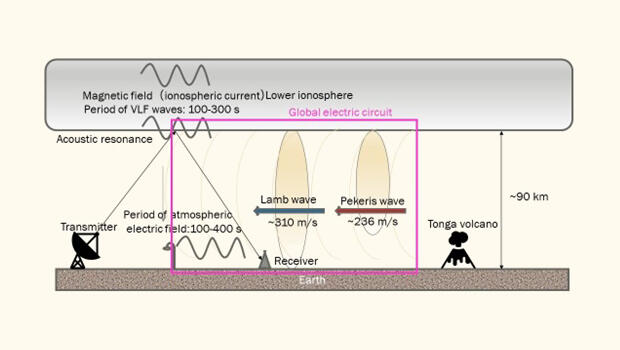A research team comprising Assistant Professor Hiroyo Ohya of the Graduate School of Engineering and Professor Emeritus Tamio Takamura of the Center for Environmental Remote Sensing at Chiba University, Professor Fuminori Tsuchiya of the Graduate School of Science at Tohoku University, Professor Yukihiro Takahashi of the Graduate School of Science at Hokkaido University, and Research Fellow Hiroyuki Shinagawa of the International Center for Space and Planetary Environmental Science at Kyushu University investigated the impact of the Hunga Tonga-Haʻapai eruption, which occurred on January 15, 2022, on the lower ionosphere. They revealed for the first time that the altitude of the lower ionosphere (plasma density) fluctuated due to the acoustic wave resonance effect caused by Pekeris waves. Additionally, they showed that these ionospheric fluctuations caused atmospheric electric-field variations at the Earth's surface via global circuits. The findings are expected to lead not only to a better understanding of the coupling between the atmosphere and ionosphere but also to a better understanding of the characteristics of Pekeris waves. The work was published in Scientific Reports.

Provided by Chiba University
It has been reported that the Tongan volcanic eruption was accompanied by Lamb and Pekeris waves as well as atmospheric gravity waves that caused various ionospheric disturbances. However, the mechanism by which the lower ionosphere, the point of passage from the atmosphere to the ionosphere, is altered by Lamb and Pekeris waves has not been clarified.
In this research, the team received standard radio waves reflected from the lower ionosphere in Taiwan to investigate the variation in the plasma density in the lower ionosphere. The research team has established the Southeast Asia VLF Band Electromagnetic Observation Network (AVON) for lower ionosphere and lightning observations in Southeast Asia, and Taiwan has one such AVON receiving station.
Analysis showed that the atmospheric pressure at the surface varied more due to Lamb waves than due to Pekeris waves, while the lower ionosphere (amplitude of the three-path standard) had a greater amplitude of variation for Pekeris waves than that for Lamb waves. Pekeris waves were predicted to have a small amplitude at the Earth's surface and a large amplitude at lower ionospheric altitudes because of sonic resonance at altitudes above approximately 30 km, where the neutral atmospheric temperature in the stratosphere and mesosphere is minimal. The fact that large fluctuations were observed in the lower ionosphere while the atmospheric pressure at the Earth's surface was very small is considered to be an observational proof of this prediction.
Simulations of neutral winds showed that the velocity of Pekeris waves was greater than that of Lamb waves at the standard reflection altitude (90 km). This suggests that the sonic resonance of the Pekeris wave causes the ionospheric plasma density to fluctuate more than that of the Lamb wave. The period of time variation of the horizontal neutral wind was similar for the Lamb and Pekeris waves. When the Pekeris wave arrived in the lower ionosphere, fluctuations in the atmospheric electric field at the Earth's surface similar to those seen in the standard radio waves were observed. At the arrival time of the Pekeris wave, the atmospheric electric field fluctuated over a period of 100 to 1000 seconds. This fluctuation is considered a reflection of variations in the lower ionosphere reflected at the Earth's surface via the global electric circuit.
This study shows that the lower ionosphere fluctuates due to Pekeris waves generated by volcanic eruptions. Ionospheric fluctuations are caused not only by solar flares and geomagnetic storms, but also by large-scale natural phenomena on the ground, and the results are useful for developing comprehensive space weather models. The ionosphere plays an important role in long-distance wireless communications. Understanding the characteristics of the Pekeris wave enables comprehension of the characteristics and fluctuations of the ionosphere and improvement of the quality and reliability of wireless communications.
Journal Information
Publication: Scientific Reports
Title: Lower ionospheric resonance caused by Pekeris wave induced by 2022 Tonga volcanic eruption
DOI: 10.1038/s41598-024-65929-x
This article has been translated by JST with permission from The Science News Ltd. (https://sci-news.co.jp/). Unauthorized reproduction of the article and photographs is prohibited.




